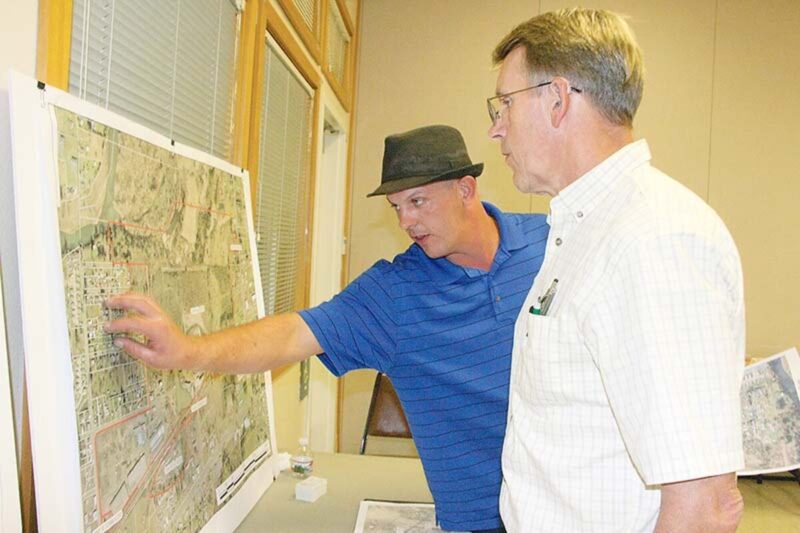Sean C. Morgan
Health and environmental agencies have completed a four-year process of testing and investigation at the site of the former Willamette Industries Sweet Home Mill.
Next, they will begin looking at options for cleanup of four areas on the 153-acre property, located at 2210 Tamarack St., and additional data gathering.
Officials held a public informational meeting Thursday evening, Sept. 27, to outline their findings.
The U.S. Environmental Protection Agency awarded a $350,000 grant to Linn County with a project period of Oct. 1, 2014 to Sept. 30 to complete site assessments. Linn County foreclosed on the property at the end of 2010 for nonpayment of property taxes by Western States Land Reliance Trust.
WSLRT had purchased the property from Weyerhaeuser, which took possession in the late 1990s as part of a hostile takeover of Willamette Industries, which had operated the mill for decades.
WSLRT began initial environmental assessments on the property, and the preliminary results gave the Oregon Department of Environmental Quality 13 areas to investigate, said Nancy Sawka of the DEQ. What the investigators found was typical of mill sites. They found contamination in five areas.
Sediments in the mill’s three ponds contained concentrations of petroleum hydrocarbons, hydrocarbon constituents, metals and dioxins above human and ecological screening levels, Sawka said. The contamination is likely caused by multiple sources, including uphill sources, mill operations, oiling tie-down chains within the pond and storm water flows from other areas.
Soil and groundwater in the vicinity of the former hydraulic areas contain petroleum hydrocarbons, Sawka said. The likely source are the former hydraulic units and transformers.
Shallow groundwater across much of the site has been impacted by formaldehyde, diesel and oil, Sawka said. The primary source is likely associated with spills or drips from the former resin tanks, impacting the entire site.
Soil around the former spray booth and the former wigwam burner contain dioxins, Sawka said. The likely source is the operation of the burner and spray booth where pentachlorophenol was used.
The impact of the contamination depends on the use of the property, Sawka said. Surface soil contamination will affect residential occupants, while shallow soil contamination, down about 3 feet, can affect construction workers. Sediment contamination will affect residents and construction workers, and shallow groundwater contamination can affect residential tap water.
Cleanup will likely be required in four areas, at a cost of $4 to $8 million, said Rick Partipilo, project manager with Linn County Department of Health Services.
Three solutions exist for most of the site, including excavation and transporting the material to a waste disposal site, capping it in place with a hard surface or excavating, consolidating and capping the material.
For the area around the wigwam burner and paint booth, excavation of 2,460 tons of soil is estimated at $700,000, while consolidating and capping it costs about $300,000, Sawka said. The recommendation is to consolidate and cap it.
In the hydraulic area, excavation and removal of 1,050 tons of soil is estimated at $370,000, while consolidating and capping it is $360,000, Sawka said. The recommendation is to excavate and remove it so the property has no deed restrictions based on having capped material.
The most extensive cleanup is 36,680 tons of material from the ponds, Sawka said. To excavate and remove it will cost around $5.8 million, while capping it in place would cost an estimated $1.7 million, and consolidating and capping it is $1.9 million.
The area requires additional testing to see if the contaminants are leaching into the soil to determine whether the ponds need to be lined, Sawka said.
To address shallow groundwater contamination, domestic wells can be replaced with deeper wells for about $1.4 million, Sawka said. They can be connected to the city water supply for $1.3 million, and individual well heads can be used to treat the water for about $1.2 million.
That project is necessary only if unsafe levels of contamination are found in groundwater off-site, Sawka said. Initially, 21 wells northwest of the property in the 18th Avenue, Willow and Yucca areas were tested, revealing high formaldehyde contamination.
The test wasn’t reliable, Sawka said, and followup testing using different methods indicated that formaldehyde levels were at safe levels.
Weyerhaeuser assisted in the formaldehyde testing, Sawka said.
Data gaps remain following the site assessment, she said. The source and extent of formaldehyde contamination remains unclear. The extent of hydrocarbon and dioxin contamination remains unknown.
Additional groundwater monitoring should be done to provide four quarters of data allowing researchers to evaluate seasonal fluctuations, she said.
Sawka said the county should continue groundwater monitoring, continue securing the property, prohibit fishing, prohibit the use of ground water on the site and clean up the dioxin at the wigwam burner and paint booth.
The next steps are to find funding to fill in the data gaps and clean up the property, Sawka said. DEQ can issue partial “no further action” notices to allow the county to sell parts of the property unaffected by contaminants.
During the presentation, Todd Hudson of the Oregon Health Authority, said he looked at the off-site formaldehyde contamination. Ultimately, the testing showed it was at safe levels.
He explained that what little formaldehyde is present is present everywhere.
Formaldehyde can be found in bottled water if it’s boiled using ozone, he said. It gets into homes through new carpet and furniture – anything that uses adhesives and glues. Plastic fittings in plumbing can put small amounts of it into well water.
“We live in formaldehyde?” asked Ken Bronson, a local resident attending the meeting.
“In a few words, yes,” Hudson said. “It’s basically all around us.”
Even ripening fruit and the human body can create formaldehyde, Hudson said.
“The good news is we know what we’re dealing with now,” Partipilo said. “Four years ago, we didn’t.”
Partipilo said the cleanup and additional testing can be completed in small steps, noting that the EPA awards $250,000 grants for those kinds of projects.
He suggested forming a joint work group that would include the City of Sweet Home.
“I still don’t understand why Weyerhaeuser isn’t responsible for some of this,” said City Councilor Dave Trask.
Sawka said her supervisor is looking into how to move forward with Weyerhaeuser, but that issue is “above my pay grade.”
The city and the county did not create the problem, Trask said.
“There are reasons they feel they’re not the responsible party,” Sawka said.
Partipilo said that a court case could slow down the process.
“When the lawsuits are filed, the community, the county, the city lose control,” he said.
In the meantime, the county is looking for ways to pull down the old buildings, one of which has been partially demolished and left standing when the EPA stopped the demolition and charged the managing trustee for WSLRT, Dan Desler, for air pollution.
Desler was sentenced in 2012 to five months of home detention, three years of probation and $1.59 million in restitution as part of a plea bargain.
The EPA removed more than 4 million pounds of asbestos-containing debris from the site, according to EPA figures, but the half-demolished building has remained standing since then.
“It would be nice to get those buildings down,” Partipilo said, after a member of the audience called them “eyesores.”





